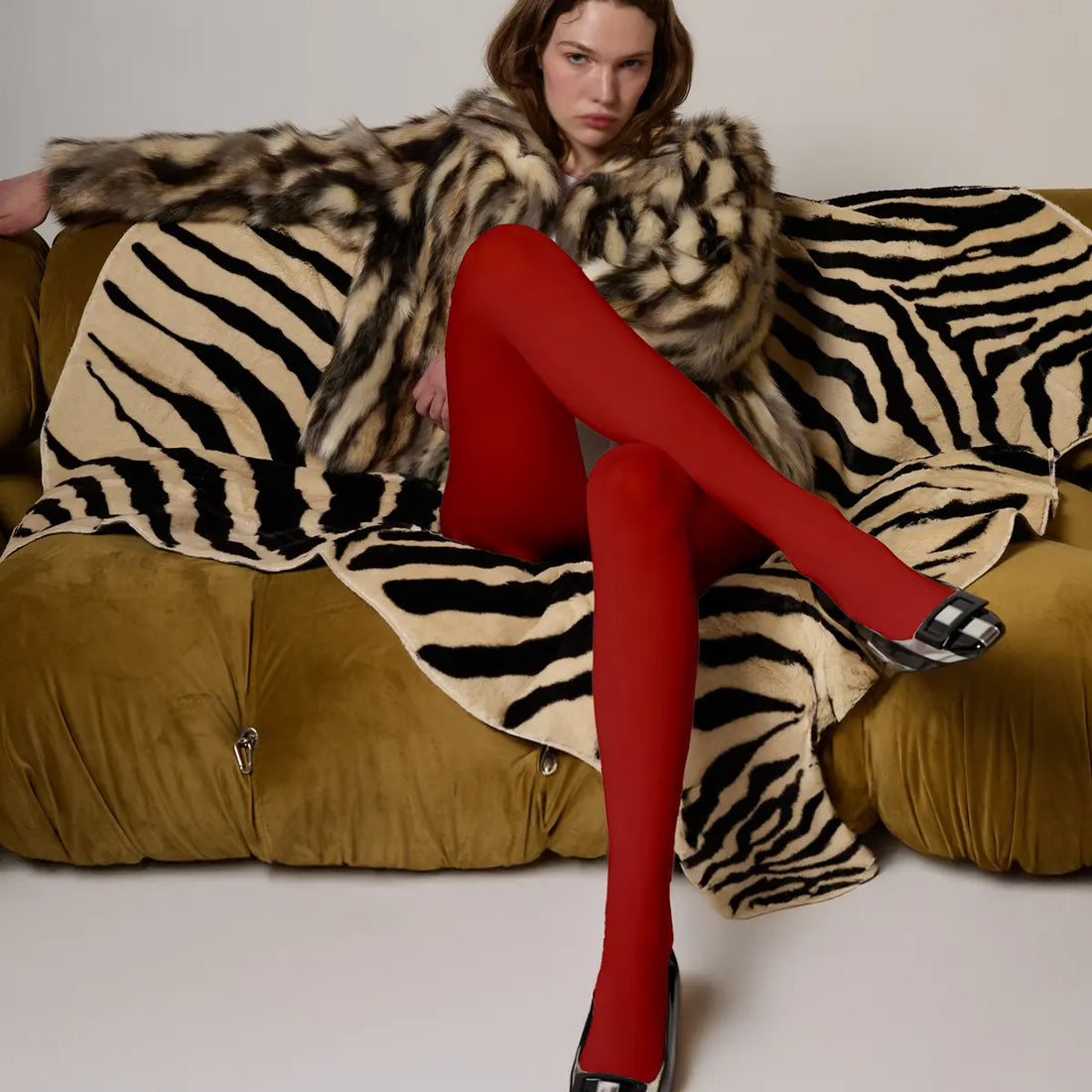Ever notice how some tights feel sheer while others look almost solid? That’s where denier and opacity come in. They’re the two little words that decide if your hosiery feels whisper-light or fully covered. But they’re not the same thing. Denier tells you about the thickness of the fibers. Opacity describes how much skin shows through. Knowing the difference saves you from surprises, and helps you pick the perfect pair for work, evenings out, or cozy weekends in.
What is Denier?
Denier measures the thickness of the fibers in your hosiery. The higher the denier value, the stronger (and thicker) the fabric. 10-20 denier, for example, feels ultra-sheer, almost like a whisper on your skin. 30-40 denier offers a lighter veil of coverage. 50+ is a lot more opaque and durable. You can even find tights that go up to 300 denier!
Denier is basically the number on the label that tells you how “substantial” the tights will feel.
What is Opaque?
Opacity is about coverage. It’s the actual look; how much of your skin shows through? A pair can have a medium denier but still appear more or less opaque depending on color. Weave and finish also matter.
As a rule of thumb, low opacity allows your skin to peek through. Medium opacity is a balance between transparency and coverage. High opacity comes down to a bold, full coverage option.
Simply, opacity is what you see. Denier is what the fibers are.

How Denier and Opaque Work Together
A point where you might get confused. Why? Because higher density usually means higher opacity, but not always. Take, as an example, black tights. 30 denier can look more opaque than nude tights in the same denier. Just like that, fabrics with tighter knits appear more opaque even if the denier isn’t high. So, denier sets the base. Opacity finishes the look.
Why Denier vs. Opacity Matters
To save you from “oops” moments. You obviously don’t want to head into a boardroom wearing tights that seem opaque but are actually the most see-through under lights.
Fashion designers suggest…
Workwear- Medium to high opacity
Casual looks- Semi-sheer for something light
Evening style- Sheer tights that add elegance without overwhelming
Match the vibe to the occasion, and you’re good to go.
20 vs. 40 vs. 80 Denier
20 denier- Light. Sheer. Almost invisible. Perfect for evenings, but prone to snags.
40 denier- The middle ground. Semi-sheer with a touch of strength. Super versatile.
80 denier- Opaque. Bold. Practical. Perfect for the colder months. Incredibly durable.

Warmth Based on Denier and Opacity
When it comes to warmth, denier does the heavy lifting. The thicker the fibers, the more insulation you get. That’s why 70–100+ denier tights feel cozy on winter mornings, but 10–20 denier styles feel almost weightless.
Opacity plays a role too, but it’s mostly visual. Opaque tights often look warmer because they fully cover the leg, yet the real warmth comes from higher denier counts. So, if you want style without bulk in summer, go sheer. If you’re braving cold winds, opaque tights with a high denier number are your best bet.
Higher Denier, Greater Durability?
Not entirely true, but it is a trend in thicker leg wear for offering greater durability. The type of yarn matters more. But the difference between, for example, a 10 and a 150 denier will be colossal in terms of durability, regardless of the yarn.
At the same denier, the quality of the fibers and the knit construction make a big difference. Two pairs of 40-denier tights can perform very differently. One might snag easily if it’s made with cheaper nylon; another with a tighter weave and added elastane will last much longer. The takeaway? Denier should be treated as a guideline, not an absolute promise.
Premium brands, such as Stems, often use microfiber yarns or 3D knitting techniques to add elasticity without pushing denier numbers sky-high. So yes, higher denier often means more durable, but fiber type and craftsmanship are equally important.
Choosing the Right Denier and Opacity for You
The best pair comes down to three things: occasion, season, and style.
Think, for the office, medium-to-high denier in darker shades. Semi-sheer denier (30-40) works best for casual days. And if you’re heading for an evening dineout, ultra-sheer (10-20) denier is your best buddy. For a stunning statement, very high denier options (150-300) serve perfectly. Don’t forget to consider the color because darker shades look more opaque at lower deniers; nude options will need a higher denier for the same effect.

Pairing with Your Wardrobe
- With dresses, 20-40 denier
- With skirts, you can experiment in the 30-40 denier range
- With shorts, higher denier tights work great with tailored shorts
Sheer style for elegance. Semi-sheer for everyday ease. Opaque for bold confidence.
Care and Longevity
Denier also affects durability. Lower denier tights (sheer) are fragile. They snag or run easily. Higher denier tights last longer and resist wear and tear. Pro tip number 1 is to always hand-wash tights or use a mesh bag in the wash. Plus, make sure to avoid rough surfaces that can catch fibers. Finally, store rolled, not folded, to avoid snags.
Common Myths… and the Truth
Myth: Higher denier always means opaque.
Truth: Not necessarily. The color (+ weave and finish) plays a role, too.
Myth: Nude tights look the same across brands.
Truth: Shade ranges differ widely. Always test against your skin tone.
Myth: Sheer tights are only for evenings.
Truth: Sheer styles can always be worn in the daytime, especially if the goal is a polished look.

Final Words
Denier and opacity may sound like insider fashion jargon, but they’re really just your guide to finding the perfect pair of tights. Denier explains thickness. Opacity shows coverage. Together, they help you avoid surprises, so you can step out feeling confident in every outfit.
![]()
